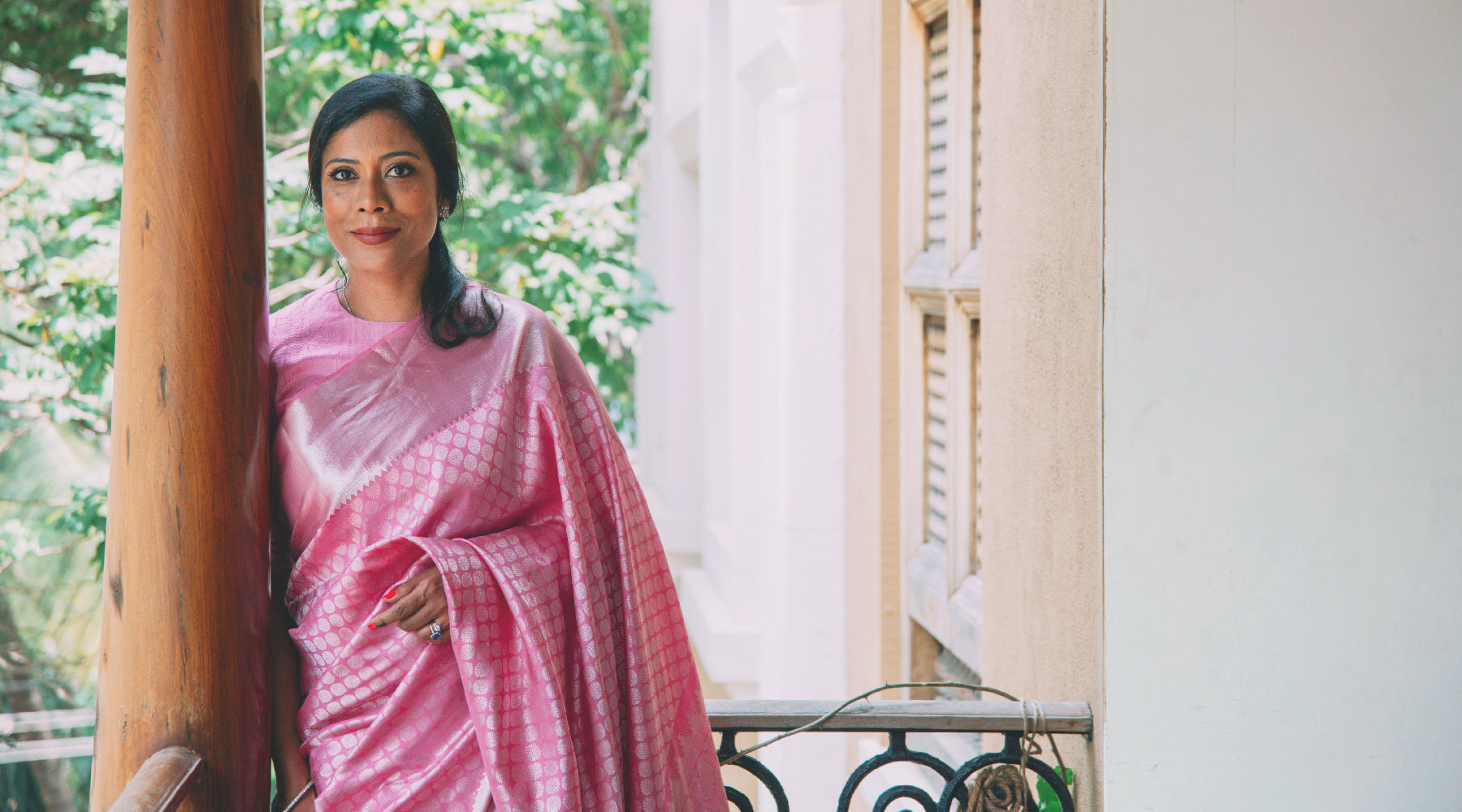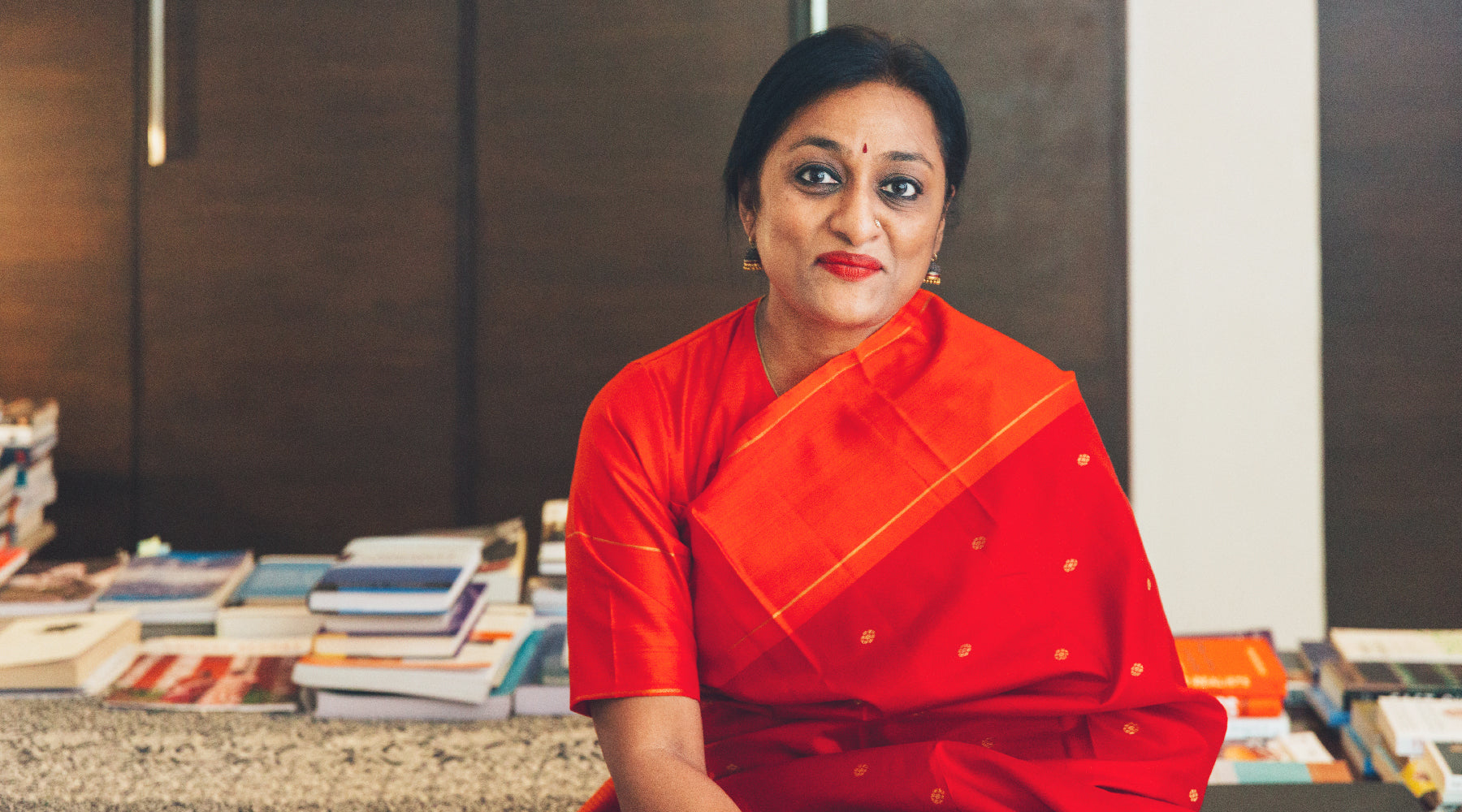KANAKAVALLI VIGNETTES : Jayanthi Kumaresh - Serenading Tradition

Jayanthi Kumaresh has been playing the Veena since the age of three, and has spent most of her life listening to, performing and immersing herself in the world of Carnatic music. And yet, she has explored music beyond tradition and performance; as a composer, a collaborator and an academic. Having performed in places as diverse as religious festivals and corporate product launch events, playing alongside guitarists, pianists and Hindustani singers, Jayanthi truly believes in the versatility of her art form, and its relevance even in a modern context. In conversation with Aneesha Bangera of the Kanakavalli Journal for July’s Vignettes, Jayanthi remembers what it was like growing up in a family of musicians and studying under the tutelage of her aunt in a Gurukul system of learning. She tells us how she bridges the gap between the classic and the contemporary in her work, and about the experience of performing with her husband in their ongoing collaboration, ‘Strings Attached’. Having recently returned from a whirlwind tour of the UK, Jayanthi takes time out of her busy practice and performance schedule to curate a selection of beautiful kanjivarams from the Kanakavalli repertoire. Excerpts of the conversation below…
Serenading Tradition
Tell us a little bit about how your musical journey began? How did you choose the Veena as your instrument?
To be honest, I’m not sure if I chose the Veena, or if the Veena chose me. I come from a family in which there have been musicians for the last six generations. Most of them were very accomplished violinists, except for my mother’s elder sister, who was my guru and was the only Veena artiste in the family. My mother started me off on music lessons, and at age three I began learning how to play the Veena. My mother was my first teacher, and in a way, I grew up with the instrument. At the age of 13 I went to live with my aunt, the renowned Veena artiste Padmavathy Ananthagopalan. I shifted from Bangalore, where I lived with my family, to Chennai, where I began to live with her and study under her in what was then known as the Gurukul system of learning. I attended school and college in Chennai, while undergoing rigorous training in Carnatic music. I had the opportunity to start performing when I was just 14 or 15 years old, and that was something quite special. My aunt was a very strict teacher and a real disciplinarian. I remember it being a real shock, as I had been quite pampered by my parents and this was a big change for me. But it was an incredible learning experience and I believe she was one of the greatest gurus ever. She was a wonderful, supportive teacher. She wouldn’t just force me to wake up at 4AM and start practice, but she would wake up just as early too and be there with me, at every step of the journey. It was tough, but it is what made me the musician I am today. I feel so fortunate to have had a guru like her.

Coming from a family of musicians, what is your most cherished memory of music from your childhood?
My mother’s brother is one of the most celebrated legends in the world of Carnatic music; the violin artiste par excellence, Lalgudi Jayaraman. He was world famous, and people adored him, literally worshipping the earth he walked on. He used to live in Chennai when I was a child, and whenever he performed in Bangalore he would come and stay with us. And these occasions were the absolute highlights of my childhood. I was always spellbound by his persona; I would watch him practice, observe him as he prepared for a concert. He was truly an incredible person and performer. And then the concerts themselves – it was amazing to watch him perform in front of huge audiences. I would sit with my family and I remember feeling so proud of my uncle. These experiences of interacting with and watching my uncle are imprinted in my memory, and they will stay with me forever.

You live many lives – as a performing artiste, a collaborator, a composer, teacher and academic. How do these many roles feed into each other in your musical life?
When you’re playing a very traditional art form, like Carnatic music, you have to ensure that you make sense even in the contemporary context. I often say that Carnatic music is as old as 2000 years and as new as tomorrow. I believe that as a classical artiste, I have to make my art form seem pertinent in today’s world, for today’s audiences. In order to bridge this perceived gap between the ancient and the modern, I also work as a researcher and academic, I collaborate and innovate, I think about art and communication. I always ask myself how my audience can find resonance with my music, how they can incorporate some element of the Carnatic Veena – a symbol of our country’s art and culture – in their everyday life. For my doctorate, I immersed myself in the history of the Veena, and the different styles of playing this magnificent instrument. All of these efforts come together seamlessly in my life, helping me bridge the gap between playing the Veena myself and helping people truly understand both the instrument and the music.
Can you tell us a little bit about how the traditional and the contemporary come together in your work?
For me, tradition is all about addition. When I play the Veena, I am very conscious of the fact that I am presenting the National Instrument of India – the Saraswathi Veena – to the audience. I am acutely aware of this great responsibility. And the idea is to show the beautiful versatility of this instrument. I’m able to play with guitarists, pianists, tabla players, drummers… My work spans the traditional repertoire and the modern. I think as long as you do everything very artistically and with great care and attention, you won’t be leaving the boundaries of tradition. I think that if you place yourself very gracefully at the intersection of the classic and the contemporary, you can transform the perception of something very traditional like the classical Veena – even making it seem ‘cool’ to younger generations of listeners. I love to show the versatility of my instrument – I can perform at a Carnatic concert and I have also performed with the British Philharmonia; I have performed with Ustad Zakir Hussain at the San Francisco Jazz Festival, and at the BBC Proms at the Royal Albert Hall, to diverse international audiences. I perform with a modern band and we call ourselves ‘Indian Spice’, and I enjoy playing with the maestros of Hindustani classical music as well. If you are able to put the instrument in diverse ecosystems, you can show how relevant it continues to be, in any scenario.
We hear you and your husband perform as a team as 'Strings Attached'. Can you tell us a little bit about this experience?
My husband, a violinist, performs with his brother as part of the Ganesh Kumaresh duo, and he also has his own solo concerts. For many years, we would jam together at home, but it was always very casual until we began collaborating and performing more seriously. We come from two very different schools of music, so we had to create a new idiom to play together, composing pieces that we wouldn’t play at concerts, except together as ‘Strings Attached’. We perform unique compositions together that we believe project the distinct voices of the Veena and the violin. These songs are special because they are presented almost as a conversation between the two instruments. All the music we create together has sections and spaces in which one of the instruments comes to the forefront and is highlighted. And it all has a very equal balance of the dynamics of both instruments. I think we have found a way of bringing together the two instruments in a way that is truly unique and that celebrates both of them.

How would you define beauty and tradition, particularly in your personal life, as well as in your work?
For me, beauty and tradition are all about proportion. I truly believe that both these elements are like salt. Salt gives essential flavour to food and elevates it, but if you have too much it ruins the meal. So, I am always wary of overdoing anything, of being too excessive or too loud. I believe in being traditional in such a way that it is artistic, eloquent, graceful. There is nothing vulgar about tradition the way I see it. The way you dress describes your personality in a very big way; it is a statement of who you are, and where you come from. And beauty, to me, is more about restraint than about excess.
Is the sari – and the kanjivaram in particular – an important part of your daily life?
The sari is my work wear. I wear kanjivarams to every single concert, and I have been for a very long time.. I tend to wear a lot of off-whites; in fact, the first sari I bought from Kanakavalli was a beautiful off-white one. Somehow when I think about the Veena, the image of Saraswathi comes to me, and I gravitate towards shades of cream and off-white, with different borders and designs. For concerts, I do also wear other colours, but I am careful to choose shades that will look beautiful on stage, amid all the lighting. I don’t wear too much zari, I like to keep things slightly more subtle. I love kanjivarams; I love the weave, the texture, the quality and the fall of the silk. I love how every detail is so beautifully put together in each sari.

What's the story behind the kanjivaram you have chosen to wear for Vignettes?
I bought this gorgeous peacock blue kanjivaram with a black border at Kingsley in early June, and I wore it while performing at a concert in London during a recent tour of the UK. It is a very traditional sari, with classic checks, and I absolutely love it. It doesn’t have too much zari and is extraordinarily elegant. I was told that it was woven by one of Kanchipuram’s master weavers, and it really is a special sari.
- Jayanthi Kumaresh, in conversation with Aneesha Bangera
Explore Jayanthi's curation here.



